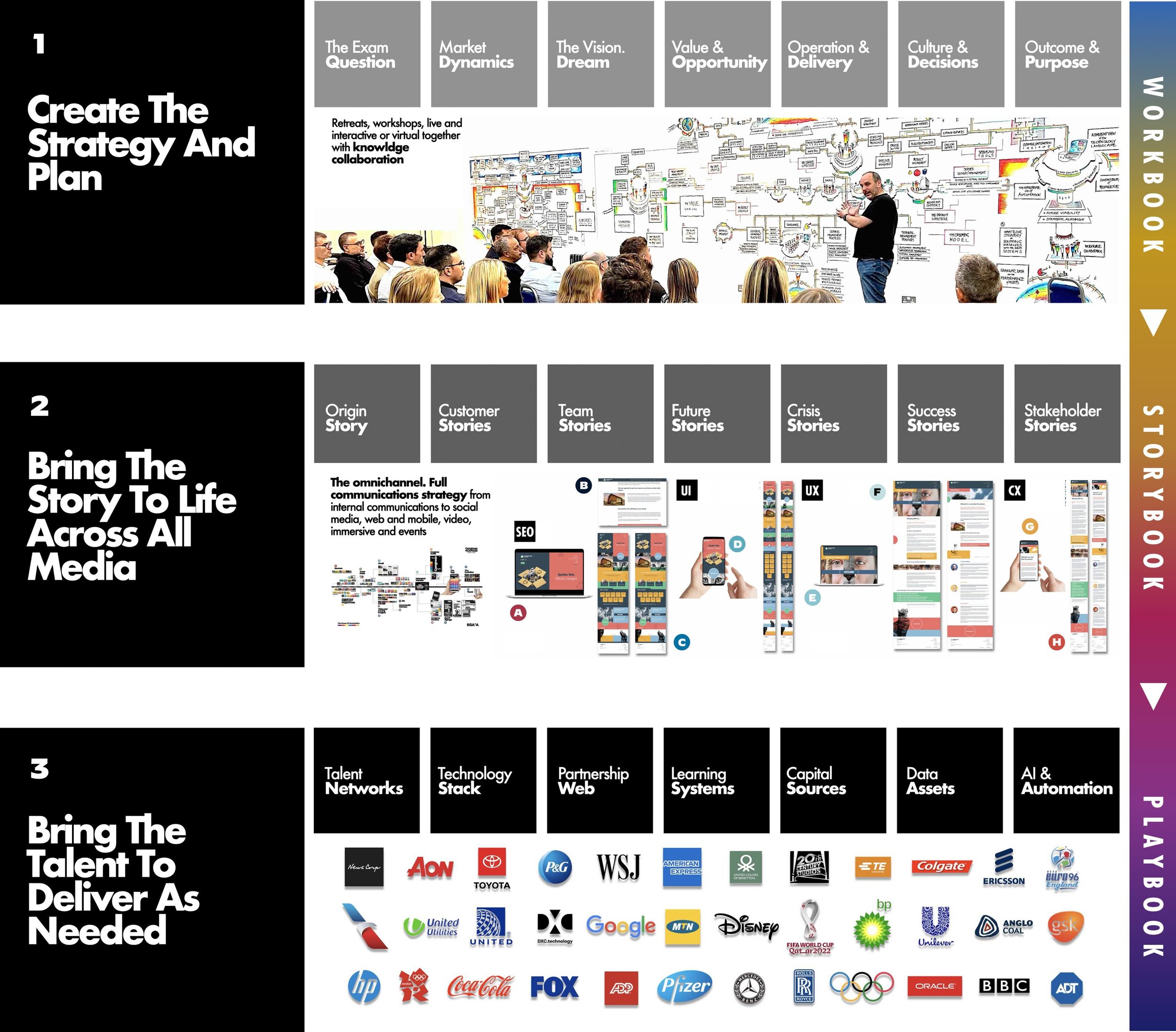
Over the past 25 years, we’ve proven that dreams come true when strategy aligns with marketing.
And when the teams doing the work align with each other.
Our model was forged from being clients and having a strong desire for performance without drama. We can describe it through three lenses.
Workbook - the framework that makes dreams achievable.
Storybook - a system of ‘story’ to make the business impossible to ignore
Playbook - orchestration of resources - boundaryless ‘agency’
The proven principles of Structured Visual Thinking™ and Framework Science™
Creating clarity through the chaos - turning complex challenges into compelling opportunities.
Explaining the model in visual terms:
The Three Books
WORKBOOK - Strategic Architecture
“Strategy without tactics is the slowest route to victory. Tactics without strategy is the noise before defeat." - Sun Tzu
This is where we start.
Create the strategic backbone with the client leadership team. The framework comprises discrete modules - critical pillars that transform dreams into operational reality.
Dynamics Pillar: The world in which we operate
Purpose Pillar: Why the business exists beyond profit
Vision Pillar: The ‘North Star’ that guides every decision
Operational Pillar: How we deliver the dream
Value Creation Pillar: How the business generates sustainable worth
Innovation Pillar: The engine for continuous renewal and exploitation of opportunity
Resilience Pillar: Built-in adaptability for navigating uncertainty
Cultural Pillar: The invisible force that binds everything together and the right leadership/decisions
Each pillar must be load-bearing, interconnected, and regularly tested against reality.
2. The STORYBOOK - Narrative Ecosystem
"The single biggest problem in communication is the illusion that it has taken place." - George Bernard Shaw*
The workbook gives us the clues and direction to build the storybook. This ensures the business will resonate with its audiences and is never a best-kept secret:
Origin Story: Where we came from and why it matters
Customer Stories: How we transform lives and solve problems
Team Stories: The human face of the organisation
Future Stories: Where we're heading and why it's exciting
Crisis Stories: How we handle adversity and learn from failure
Success Stories: Proof points that build confidence
Stakeholder Stories: The narrative that inspires interest and desire.
The storybook is far beyond telling - it's about creating narratives that resonate across every touchpoint, channel, and stakeholder group.
3. The PLAYBOOK -
Resource Orchestration
“Talent wins games, but teamwork and intelligence win championships." - Michael Jordan*
Where capability meets opportunity in our age of fluid boundaries. We now know enough to make certain we do not solve the wrong problem really well.
Talent Networks: Beyond employees to ecosystems of expertise
Technology Stack: Tools that amplify human potential
Partnership Web: Strategic alliances that multiply impact
Learning Systems: Continuous capability building
Capital Sources: Financial fuel from traditional and innovative channels
Data Assets: Information as a Competitive Advantage
AI & Automation: The gradual replacement of rote tasks in favour of human performance
The playbook recognizes that in the era of ‘agency’ (not agencies), resources flow to where they create most value.
The Interconnected Model
These frameworks don't operate in isolation - they form a dynamic system:
Dreams flow through the Workbook to become structured possibilities
The Workbook informs the Storybook - strategy shapes narrative
The Storybook attracts the Playbook - compelling stories draw resources
The Playbook enables the Workbook - resources fuel strategic execution
The cycle amplifies the Dream - success breeds bigger dreams
High-level Explainer
Operating in Complexity
In our VUCA world (Volatile, Uncertain, Complex, Ambiguous), this model offers:
Clarity in chaos: Frameworks provide structure without rigidity
Adaptive capacity: Each framework can evolve independently while maintaining coherence
Network effects: External resources multiply internal capabilities
Narrative power: Stories cut through information overload
Dream resilience: When one path closes, the dream finds another
The beauty of this model is its fractal nature - it works at every scale, from startup to enterprise, from team to ecosystem.
Core Principles of the Model
ONE - The Exam Question Principle
Avoid solving the wrong problem really well
Each framework has a defining question, and generally, they will be based on the following:
WORKBOOK: "What needs to be true for our dream to become reality?" (Strategy)
STORYBOOK: "How do we make our vision irresistible to those who matter?" (Communication)
PLAYBOOK: "What capabilities must we orchestrate to deliver our promise?" (Execution)
Dreams drive strategy, not the other way around. Leaders who start with tactics end with mediocrity.
TWO: Module Interconnection Principle
From Framework Science™ - each module causes us to comprehend and then tell its own story, but it all gains compound power through connection:
Dream → Context/Vision → Outcomes → Achievements → Actions → Measures
This creates Framework Integrity™, where changing one element ripples through the entire system.
The future belongs to those who can see systems, not just parts. Everything connects to everything else.
THREE: Visual Logic Principle
Transform abstract concepts into tangible visual relationships:
Show dependencies between pillars in the Workbook
Map narrative flows in the Storybook
Visualise resource networks in the Playbook
Create a ‘Blueprint’ showing how all three frameworks create value together
FOUR: Collaborative Discovery Principle
“The answers lie within the team, not in pre-baked solutions"
Use visual sessions and/or extended research to co-create each framework
Build emotional ownership through participation
Transfer capability, don't create dependency
FIVE: Dynamic Integrity Principle
Frameworks must evolve while maintaining coherence:
Regular "integrity checks" ensure alignment
New information updates the entire system
Feedback loops keep frameworks current
Assessment tools measure ‘framework’ health
SIX: Definition Clarity Principle
"Poorly defined concepts trigger major problems"
Create a shared taxonomy:
What exactly is a ‘dream’ vs. a ‘vision’?
Define ‘strategic pillar’ vs. "operational capability"
Establish clear success metrics for each framework
Ensure everyone shares the same mental models and definitions
SEVEN: Systems Thinking Principle
"Every business is the sum of its individuals"
Map how frameworks interact as a system
Identify leverage points for maximum impact
Show value creation flows across boundaries
Highlight interdependencies to prevent siloed thinking
EIGHT: Evidence-Based Evolution Principle
From the Framework Science™ approach:
Dreams must connect to measurable outcomes
Real achievements must back stories
Resources must deliver quantifiable value
Regular assessments validate or redirect efforts
Applying Framework Science™ to Each Level
For the WORKBOOK
Configure modules based on strategic imperatives
Create a "line of sight" from dream to execution
Build in critical success factors
Design principles guide all initiatives
For the STORYBOOK:
Map stakeholder journeys through narratives
Create story frameworks for different audiences
Build feedback mechanisms to test resonance
Visual story mapping shows narrative coherence
For the PLAYBOOK:
Create a capability blueprint (not an org chart)
Map value creation systems visually
Show resource flows and dependencies
Design operational integrity checks
The Meta-Framework
Framework Science™ - our governing framework
Sets the ‘exam question’ for the entire model
Defines relationships between the three frameworks
Establishes integrity rules for the system
Creates assessment mechanisms for health checks
Builds in adaptation pathways for evolution
Implementation Sequence
Broadly following what (in the past) we called the 4D™ methodology:
DISCOVER: Current state of dreams, stories, and resources
DEVELOP: Design the three frameworks collaboratively
DECIDE: Choose specific configurations and connections
DEPLOY: Implement with continuous integrity checks
The power of applying these principles is that they transform a conceptual model into an operational system - one that's visual, logical, collaborative, and continuously evolving.
And while others debate the death of agencies, we're building the birth of agency - where strategy meets story meets capability in a world that rewards orchestration over ownership.











